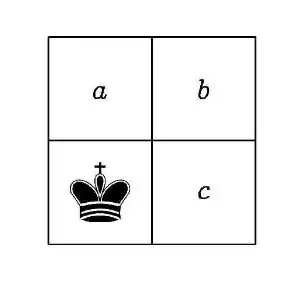Consider a random walk of a king on a standard chess board, which at each step moves to a uniformly random permitted square. What's the exact mean time to visit all squares (cover time), starting from a corner square?
Is there an algebraic solution?
Consider a random walk of a king on a standard chess board, which at each step moves to a uniformly random permitted square. What's the exact mean time to visit all squares (cover time), starting from a corner square?
Is there an algebraic solution?
There is in principle no difficulty in answering this question. As I point out in my answer here, calculating the expected cover time of some set $\cal S$ reduces to calculating the expected hitting time of every possible non-empty subset $A$ of $\cal S$:
$$\mathbb{E}(\text{cover time})=\sum_A (-1)^{|A|-1} \mathbb{E}(T_A)$$
These hitting times are defined by $T_A=\inf(n\geq 0: X_n\in A)$.
Look out below! Ignorant of chess rules, I didn't realize that a king can move diagonally. The calculations below are based on a piece that can only move in four ways: north, south, east, or west.
Just to illustrate, let me show you the solution for a $2\times 2$ chessboard:

The expected time to cover the other 3 squares ${a,b,c}$ is equal to $$\mathbb{E}(T_{a})+\mathbb{E}(T_{b})+\mathbb{E}(T_{c})-\mathbb{E}(T_{a,b})-\mathbb{E}(T_{a,c})-\mathbb{E}(T_{b,c})+\mathbb{E}(T_{a,b,c})$$
Standard Markov chain theory uses linear algebra to find these expected hitting times $$\mathbb{E}(T_{a})=\mathbb{E}(T_{c})=3, \mathbb{E}(T_{b})=4, \mathbb{E}(T_{a,b})=\mathbb{E}(T_{b,c})=2, \mathbb{E}(T_{a,c})=\mathbb{E}(T_{a,b,c})=1$$
Putting it all together, we find that the expected cover time is $3+3+4-2-2-1+1=6$.
Note that I counted the king's initial position as already covered. If you require a return to your starting point you can modify the above technique.
The number of terms in the sum make this method impractical for an $8\times 8$ chessboard, however!
Added: If my calculations are correct, the expected cover time for the $3\times 3$ board is $${140803109038245\over 4517710919176}=31.1669$$
There is an algebraic solution; the mean cover time from any node in a graph is known to be rational and can be found in exponential time. It's not likely to have a simple form, though. Experimentally, I ran the following code:
import random
def reachable((i,j)):
ok = lambda(q):(min(q)>=1 and max(q)<=8)
return filter(ok, [(i-1,j-1), (i-1,j), (i-1,j+1), (i,j-1), (i,j+1), (i+1,j-1), (i+1,j), (i+1,j+1)])
def covertime(sq, rng=random.Random()):
seen = set([sq])
path = [sq]
while len(seen)<64:
path.append(rng.choice(reachable(path[-1])))
seen.add(path[-1])
return len(path)-1
I found that the mean cover time starting from a corner square was about $597$, while the mean cover time starting from a center square was larger, about $621$.